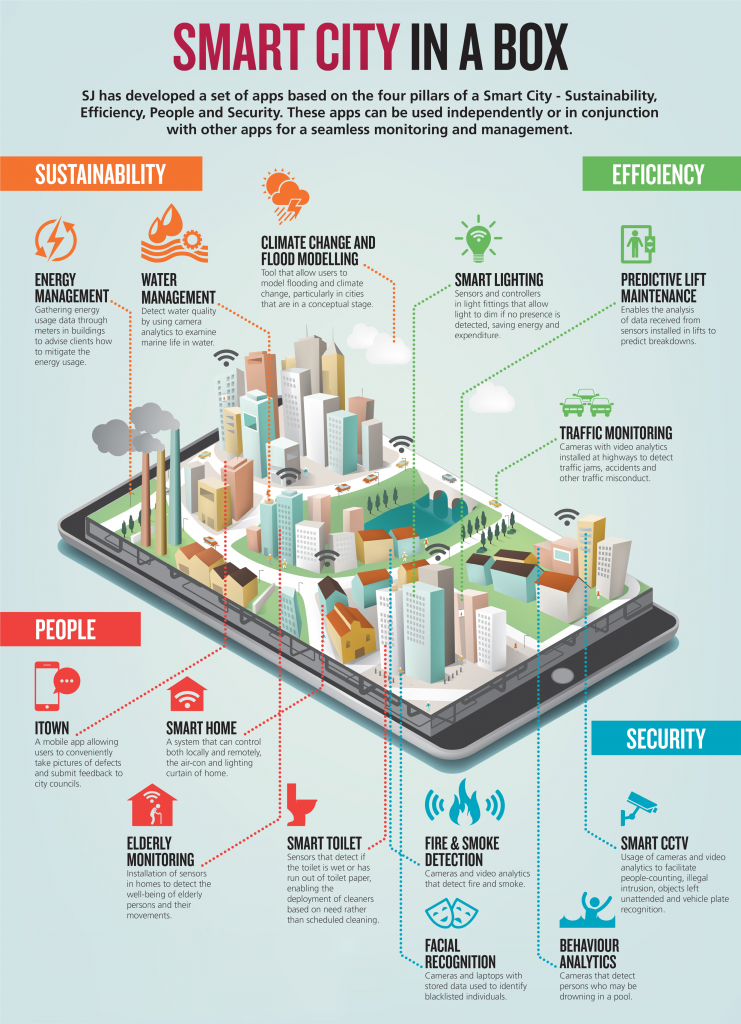Wired Smart Cities

What Makes a Town or City “Smart”?
“Smart” communities use computing and communication technology to provide innovative solutions to complex issues.The goal is to stimulate community-based social and economic improvement and enhance our quality of life. The backbone of a wired smart city is optical fiber to every home and building — an electronic highway promoting collaboration, connection, commerce, and culture.
Don’t we Need Wireless 5G to Be “Smart”?
Take a peek at this “Smart City in a Box” Diagram created by Surbana Jurong and Microsoft.

Other than ITown which is all about taking pictures with a mobile phone, every single function shown – yes, even the smart toilet! – could be better accomplished with municipal fiber than with 5G. That’s right – a wired fiber network could accomplish essentially all the same functions as wireless 5G, but would do so more economically, more reliably, and more safely. In the very few cases where wireless is needed for mobility, pre-existing wireless protocols could be used.
For the techies: 5G is all about higher data rates and lower network latency. But the sensor technologies used by “smart city” sensor networks and the Internet of Things tend to be low data-rate applications and not real-time interactive. 5G would be unnecessarily complicated and over-the-top for the stuff inside the box and for most sensor networks – things like monitoring water flow, temperature, structural factors, and traffic, and metering electricity, water and gas.
 What if I want to commute like the Jetsons?
What if I want to commute like the Jetsons?
Autonomous vehicles are currently engineered to rely on wireless signals. But 5G millimeter waves are so highly directional, short range, and easily blocked by buildings, bodies, and more, they will not offer dependable city-wide coverage. For reasons of safety and reliability, it would be foolhardy to depend on wireless signals to get us from Point A to Point B.

photo by Leigh Hilbert
The Wise Way
In his groundbreaking February 2018 report, Re-Inventing Wires: The Future of Landlines and Networks, Dr. Timothy Schoechle explains how a wired fiber infrastructure that includes wired secure gateways is the best way to achieve “smart” city applications.
Truly smart communities begin with wired community-owned fiber-to-the premises networks. The possibilities?
Sustainability
- Water systems
- Energy systems—smart grid and clean energy
- electric power grid management for localization and decentralization solar+storage
- Smart buildings (energy efficient, useful, and friendly)
- Travel reduction (better video/audio conferencing)
Efficiency
- metering of electricity, water, gas, etc
- Transportation systems (light rail, traffic signals, weather sensors, etc.)
People
- Health services
- Public services (government information dissemination)
- Education, training, and distance learning
- Work at home enablement
- Small business development through an improved ability to connect to customers/resources, trade and commerce
Security
- Public safety and emergency services
 What if I want to commute like the Jetsons?
What if I want to commute like the Jetsons?